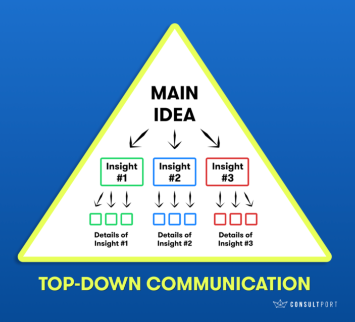Storytelling With Data: What Is It? Why Is It Important? And How to Do It?
Ever since humans learned to communicate, storytelling has been popular. To this day, people who tell stories are given the highest place in our society. For example actors, directors, authors, and the list goes on.
But can storytelling work wonders in consulting? The answer to that question is a resounding yes. Storytelling with data during presentations is pretty much the norm in many top consulting firms. However, it’s not as straightforward as it sounds. You can’t tell stories to super busy, high-level C-suite executives as if they’re 5-year-old kids.
So, what exactly does storytelling with data entail? Why is it important? And what’s the right way to execute it?
Let’s find out.
What Is Storytelling in Business?
Stories. We all love them. In fact, that’s what makes us human, our sense of imagination and creativity. Ever since childhood, we have been hearing different sorts of stories. When we grow up, we watch movies or series to satisfy our urge to consume stories, let it be crime, fiction, romance, thriller, horror, drama, or action. And those who are not into watching turn to reading. But the bottom line is that we are all fond of stories. Now you may be wondering: Is it unprofessional to bring stories into business? It’s not. Businesses are run by humans for humans. And, as mentioned before, you can barely go wrong with storytelling in business.However, the thing is, storytelling with data is different from telling stories to kids.
Basically, storytelling in business is the process of presenting facts in the form of a story rather than just listing them on a slide. Let’s consider an example to understand this better. Today, we’ll discuss the before-after-bridge method of storytelling, which follows the customer's journey from being in a problem to moving towards a solution using a company’s product or service.
”Jane is a freelance consultant with 10 years of experience in McKinsey & Company. When she moved to Berlin, she had a tough time finding freelance consulting work. Then she discovered Consultport, an online platform that connects freelance consultants and businesses. Today, she is working on two different high-paying projects, both with Fortune 500 companies.”
Now that's storytelling, and it is much easier to follow and remember as compared to bland and generic communication, for instance: ”Consultport is a freelance consulting platform. We help consultants find freelance projects.”
KEY TAKEAWAYS
- Storytelling in business is the process of presenting facts in the form of a story, rather than just listing them on a slide.
- Presenting data as a story makes it easier to remember the key points and actionable insights.
- Individuals who are not used to processing data can benefit greatly from data storytelling.
- Storytelling makes presentations more interesting and fun.
- The proper use of data visualization tools and top-down communication is essential while preparing consulting slides that are to be presented as a story.
Why Your Consulting Slide Deck Should Tell a Story
Storytelling with data may sound like an unusual idea to someone who is not used to it. But storytelling in business is very similar to telling stories to children. Let’s understand why you should also use it with business executives .
Reason #1: It makes the stats less painful to follow
”I love memorizing a lot of stats in every meeting.” This is a sentence no CEO has probably ever said. Let’s face it, numbers can stress people out. But if you leverage storytelling with data in your consulting slide deck, your presentation will become more interesting and easier to digest.
Reason #2: It helps you communicate with people who are not used to data
As a consultant, it is likely that you have a very high IQ and you can interpret complex data with ease. However, not everyone is like that. For example, if you say “78% of your web pages have a load time higher than 5 seconds and 89% of these pages have a very low session duration”, a layperson would never understand what you truly mean. Instead, you could say, “If your web pages don’t completely load by the time a user has taken one full breath, they’ll probably click on another site that is faster.”
Reason #3: Storytelling with data turns numbers into actionable insights
Let’s continue with the example that we discussed in the previous point. So, if a web page is taking more than 5 seconds to load, what can be done to fix it? In this case, an actionable insight could be to cache the web pages or minimize the number of HTTP requests, or employ any other method that a qualified web expert suggests increasing the loading speed.
Reason #4: Stories in your consulting slide deck make it easy to remember the key takeaways
Do you know how tall the Titanic was? Can you tell how many lifeboats were present onboard? Probably not. But you surely remember that Jack and Rose shared that broken door to stay afloat in the movie Titanic, and then Rose blew the whistle really hard at the end. That’s the power of stories, they are easy to remember. Similarly, in the loading speed example that we discussed previously, if you only tell your client that 78% of web pages…5 seconds…89%....bla bla bla,” they’ll probably forget it. But they’ll likely remember that their web pages need to be completely open within one breath.
How to Tell Story With Data During Consulting Presentations
Now that you understand what storytelling in business is and why it is so important, let’s shed some light on how to use storytelling in your consulting slide decks for your next presentation.

1. Use data visualization tools
Data without a story is boring and hard to remember, and a story without visuals is not as exciting as the one that stimulates our eyes. Also, since you’re telling your story to high-ranking executives and not school kids, your visuals should be professional as well. Here are some elements that you can add to your slides to enhance storytelling:
- Pie charts: Which are excellent to present proportions in a visual manner.
- Bar graphs: These can be used to compare elements that belong to two distinct groups or measure changes over time.
- Scatter plots charts and bubble charts: These ones are very useful when you want to emphasize patterns or a lack of patterns instead of numbers.
- Colors: Different colors can be used for different pieces of data to make interpretation easier.
2. Use top-down communication
When you’re reading bedtime stories to kids, it starts with once upon a time, then it slowly moves to a conclusion. In top-down communication, which is a method that consultants use, the conclusion comes first, and then it’s elaborated. Since the communication is structured like a Pyramid, this method is also called the Pyramid Principle.
In the following an example:
The main idea at the top of the pyramid: The annual operational costs can be reduced by $100,000 by improving processes.
Three insights at the second level of the pyramid:
- Insight #1: Outsource IT and marketing to save $50,000 a year.
- Insight #2: Streamline the manufacturing process by investing in new equipment to save $30,000 a year.
- Insight #3: Find a new supplier to buy raw material from to save $20,000 a year.




